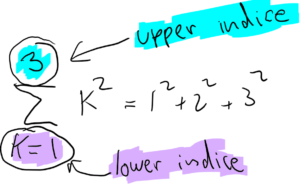Video (6 minutes) to help you with your Blackboard homework
on Parameters Statistics & Sigma Notation.
Population parameters and sample statistics
The “population‘” is the group or set of things that we are interested in. To understand the population we take a “sample” (which is just a subset) of the population and we make the actual measurements on the sample.

Squirrel living in the Boston Common. This squirrel is not a member of the Central Park squirrel population.
A population parameter is a characteristic of an entire population, e.g., the mean weight of all the squirrels in Central Park. The percent of squirrels in Central Park that prefer peanuts to raisins.
A sample statistic is a characteristic of a sample taken from a population, e.g., the mean weight of a sample of 30 squirrels from Central Park. The percent of squirrels in that sample that prefer peanuts to raisins.
There are many different types of population parameters and corresponding sample statistics.
In the table below are four of the most important ones:
- size
- mean
- standard deviation
- proportion (which is sometimes called the fraction or percent)
\begin{array}{c c c}
\hline
% after \\: \hline or \cline{col1-col2} \cline{col3-col4} …
name & statistic & parameter \\ \\
size & n & N \\ \\
mean & \bar{x} = \dfrac{\sum x}{n} & \mu_x = \dfrac{\sum x}{N} \\ \\
standard\ deviation & s_x = \sqrt{\dfrac{\sum (x – \bar{x})^2}{n-1}} &
\sigma_x = \sqrt{\dfrac{\sum (x – \mu_{x})^2}{N}} \\ \\
proportion & \hat{p} & p \\ \\
\hline
\end{array}
Cell phone users might need to switch to landscape mode to see the entire table.
We use the statistics from samples to estimate population parameters.
Example. As the sample size $n$ gets larger and closer to the population size $N$, we expect that the mean of the sample will be a better approximation of the mean of the population. We can write this as:
As $ n \rightarrow N $ we expect $| \mu_x – \bar{x}| \rightarrow 0$.
Pronunciation
$\mu$ is the Greek letter “mu” which rhymes with “new”.
$\sigma$ is the Greek letter “sigma”.
$\hat{p}$ is pronounced as “p hat”.
Sigma Notation
The symbol $ \sum $ is used to represent “sum”. $ \sum $ is the uppercase version of the Greek letter sigma.
An example of using sigma notation to express sums:

Two more examples of using sigma notation to express sums:
$$\sum_{k = 1}^{3} k^2 = 1^2 + 2^2 + 3^2 = 1 + 4 + 9 = 14$$
$$\sum_{k = 4}^{5} k^2 = 4^2 + 5^2 = 16 + 25 = 41$$
Example of using sigma notation to write the formula for the mean $\bar{x}$
If $x = x_1, x_2, \ldots, x_n$ then the mean of $x$ is given by:
$$\bar{x} = \dfrac{\sum_{k = 1}^{n} x_k}{n} $$
Note. We often suppress the upper and lower indices in formulas.

Example. The formula for the mean of $x$ is given by:
$$\bar{x} = \dfrac{\sum x}{n} $$

